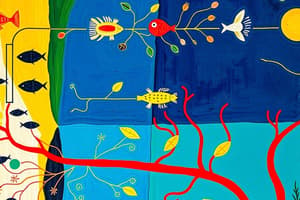Podcast
Questions and Answers
What is a primary characteristic of the first trophic level?
What is a primary characteristic of the first trophic level?
- Works as both a producer and a consumer
- Consumes other organisms
- Makes its own food (correct)
- Feeds on secondary consumers
What percentage of energy is typically available to the next trophic level?
What percentage of energy is typically available to the next trophic level?
- 25 percent
- 10 percent (correct)
- 50 percent
- 5 percent
Why are there rarely more than four trophic levels in a food chain?
Why are there rarely more than four trophic levels in a food chain?
- Insufficient food sources
- High predator competition
- Increased biomass at lower levels
- Energy loss at each level (correct)
Which of the following best describes biomass?
Which of the following best describes biomass?
Humans are considered which types of consumers based on their diet?
Humans are considered which types of consumers based on their diet?
What happens to the majority of energy at a trophic level?
What happens to the majority of energy at a trophic level?
Which trophic level includes organisms that consume primary consumers?
Which trophic level includes organisms that consume primary consumers?
What is the relationship between trophic levels and the number of organisms?
What is the relationship between trophic levels and the number of organisms?
What can ecological pyramids represent in an ecosystem?
What can ecological pyramids represent in an ecosystem?
Which of the following is an example of a tertiary consumer?
Which of the following is an example of a tertiary consumer?
What does a food chain represent in an ecosystem?
What does a food chain represent in an ecosystem?
How do food webs differ from food chains?
How do food webs differ from food chains?
What role do decomposers play in an ecosystem's energy flow?
What role do decomposers play in an ecosystem's energy flow?
What is the primary function of both food chains and food webs?
What is the primary function of both food chains and food webs?
Why are pyramids useful in ecology?
Why are pyramids useful in ecology?
Based on food webs, which statement is true about most organisms in an ecosystem?
Based on food webs, which statement is true about most organisms in an ecosystem?
What might a food chain that includes producers look like?
What might a food chain that includes producers look like?
What misconception might one have about food chains?
What misconception might one have about food chains?
What is an example of organisms consumed by cephalopods in a food web?
What is an example of organisms consumed by cephalopods in a food web?
How do food webs reflect the reality of ecosystems better than food chains?
How do food webs reflect the reality of ecosystems better than food chains?
A food chain represents multiple pathways of energy flow through an ecosystem.
A food chain represents multiple pathways of energy flow through an ecosystem.
Food webs demonstrate that most organisms eat and are eaten by more than one species.
Food webs demonstrate that most organisms eat and are eaten by more than one species.
Decomposers are typically included in simple food chains but not in food webs.
Decomposers are typically included in simple food chains but not in food webs.
In a food web, energy flows from consumers to producers.
In a food web, energy flows from consumers to producers.
The classic example of an ecological pyramid typically illustrates the biomass and energy distribution across different trophic levels.
The classic example of an ecological pyramid typically illustrates the biomass and energy distribution across different trophic levels.
Ecological pyramids can only represent the decrease in numbers of organisms within an ecosystem.
Ecological pyramids can only represent the decrease in numbers of organisms within an ecosystem.
Humans are tertiary consumers when they consume cows.
Humans are tertiary consumers when they consume cows.
The 4th trophic level typically consists of smaller organisms compared to the lower levels.
The 4th trophic level typically consists of smaller organisms compared to the lower levels.
Generally, only about 10 percent of the energy at one trophic level is available to the next level.
Generally, only about 10 percent of the energy at one trophic level is available to the next level.
An ecological pyramid will usually have more than four trophic levels due to the abundance of energy available.
An ecological pyramid will usually have more than four trophic levels due to the abundance of energy available.
Flashcards are hidden until you start studying
Study Notes
Energy Flow in Ecosystems
- Energy flow within an ecosystem is framed by the question: who eats whom?
- Food chains and food webs illustrate feeding relationships and the transfer of energy and matter.
Food Chains
- A food chain represents a single pathway of energy and matter flow within an ecosystem.
- Food chains are simplistic compared to nature's complexity, as most organisms interact with multiple species.
- Producers (like plants) and consumers (like mice and snakes) are included in an example of a food chain.
Food Webs
- Food webs consist of multiple pathways connecting various food chains, demonstrating complex feeding relationships.
- They show that most organisms have multiple dietary connections, highlighting ecosystem interdependence.
Importance of Ecological Pyramids
- Ecological pyramids illustrate the flow of energy, biomass, or organism numbers through trophic levels in ecosystems.
- They model energy use from producers through various trophic levels, emphasizing declines at higher levels.
Trophic Levels
- Trophic levels categorize organisms based on their feeding positions, generally capped at four levels:
- 1st Level: Producers create their own food (e.g., plants).
- 2nd Level: Primary consumers eat producers (e.g., mice).
- 3rd Level: Secondary consumers eat primary consumers (e.g., snakes).
- 4th Level: Tertiary consumers eat secondary consumers (e.g., hawks).
- Humans can occupy multiple trophic levels depending on their diet.
Energy Transfer in Trophic Levels
- Approximately 10% of energy is transferred to the next trophic level, with the majority (90%) lost through metabolic processes or heat.
- This energy loss limits food chains to a maximum of four levels, with a rarely occurring fifth due to insufficient energy.
Biomass and Organism Abundance
- Higher trophic levels typically support fewer organisms due to decreased available energy.
- Organisms at higher trophic levels tend to be larger, but their reduced numbers lead to lower overall biomass compared to lower levels.
Energy Flow in Ecosystems
- Energy flow within an ecosystem is framed by the question: who eats whom?
- Food chains and food webs illustrate feeding relationships and the transfer of energy and matter.
Food Chains
- A food chain represents a single pathway of energy and matter flow within an ecosystem.
- Food chains are simplistic compared to nature's complexity, as most organisms interact with multiple species.
- Producers (like plants) and consumers (like mice and snakes) are included in an example of a food chain.
Food Webs
- Food webs consist of multiple pathways connecting various food chains, demonstrating complex feeding relationships.
- They show that most organisms have multiple dietary connections, highlighting ecosystem interdependence.
Importance of Ecological Pyramids
- Ecological pyramids illustrate the flow of energy, biomass, or organism numbers through trophic levels in ecosystems.
- They model energy use from producers through various trophic levels, emphasizing declines at higher levels.
Trophic Levels
- Trophic levels categorize organisms based on their feeding positions, generally capped at four levels:
- 1st Level: Producers create their own food (e.g., plants).
- 2nd Level: Primary consumers eat producers (e.g., mice).
- 3rd Level: Secondary consumers eat primary consumers (e.g., snakes).
- 4th Level: Tertiary consumers eat secondary consumers (e.g., hawks).
- Humans can occupy multiple trophic levels depending on their diet.
Energy Transfer in Trophic Levels
- Approximately 10% of energy is transferred to the next trophic level, with the majority (90%) lost through metabolic processes or heat.
- This energy loss limits food chains to a maximum of four levels, with a rarely occurring fifth due to insufficient energy.
Biomass and Organism Abundance
- Higher trophic levels typically support fewer organisms due to decreased available energy.
- Organisms at higher trophic levels tend to be larger, but their reduced numbers lead to lower overall biomass compared to lower levels.
Studying That Suits You
Use AI to generate personalized quizzes and flashcards to suit your learning preferences.




